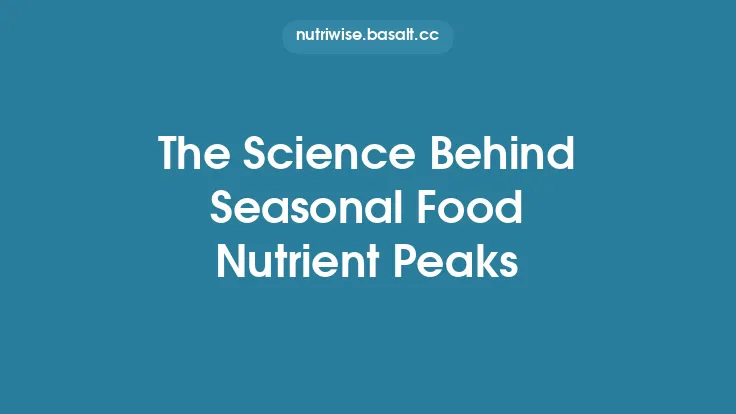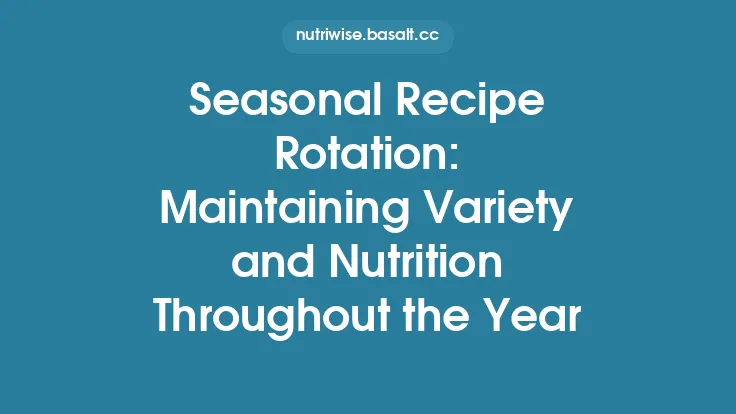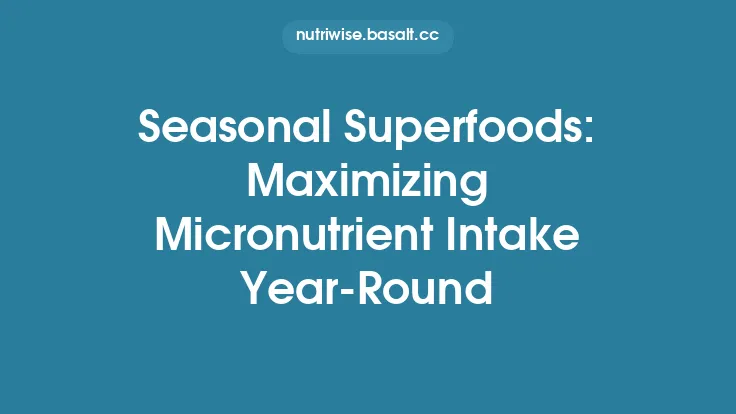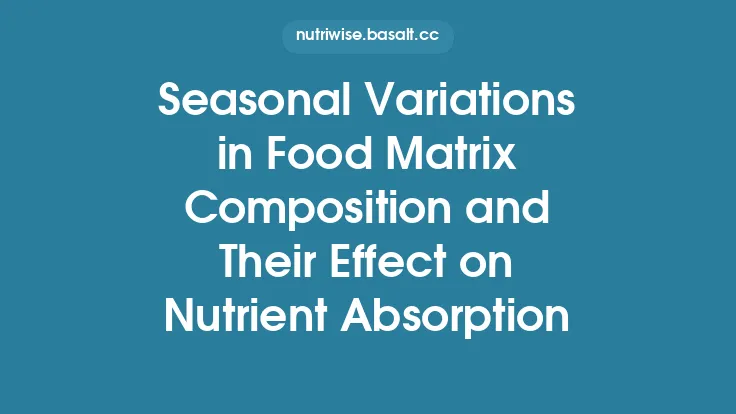Seasonal food cycles are more than a poetic notion; they are a measurable, biologically driven rhythm that determines when the nutrients in our favorite fruits, vegetables, grains, and legumes reach their highest concentrations. Across cultures, traditional calendars have long marked the optimal moments to harvest, prepare, and consume specific foods, aligning human nutrition with the natural ebb and flow of plant chemistry. Understanding these nutrient peaks empowers us to make choices that are both culturally resonant and scientifically sound, ensuring that the foods we eat deliver the maximum health benefits available at any given time of year.
The Science Behind Nutrient Fluctuations
Plants are dynamic chemical factories. Their metabolic pathways respond to external cues—light intensity, temperature, water availability, and soil composition—to synthesize a suite of primary and secondary metabolites. Primary metabolites (carbohydrates, proteins, lipids) are essential for growth, while secondary metabolites (polyphenols, flavonoids, glucosinolates, carotenoids) often serve protective roles against UV radiation, pests, and oxidative stress. The concentration of these compounds is not static; it varies throughout the plant’s life cycle:
| Plant Stage | Typical Metabolic Shift | Nutrient Implication |
|---|---|---|
| Early vegetative growth | High chlorophyll and carbohydrate synthesis | Elevated glucose, starch, and vitamin K |
| Pre‑flowering | Accumulation of storage proteins and lipids | Increased protein, essential fatty acids |
| Flowering & fruit set | Surge in antioxidant compounds to protect reproductive tissue | Peaks in vitamin C, anthocyanins, carotenoids |
| Ripening | Conversion of starches to sugars; breakdown of cell walls | Higher soluble sugars, vitamin A precursors, flavonoids |
| Senescence | Redistribution of nutrients to seeds | Concentrated minerals (iron, zinc) in seed tissues |
These shifts are driven by gene expression changes that are tightly regulated by circadian rhythms and environmental signals. For example, the expression of the *CHS* (chalcone synthase) gene, a key enzyme in flavonoid biosynthesis, spikes under high UV exposure, leading to a measurable increase in flavonoid content in the outer layers of fruits and leaves.
Phenology and Plant Metabolism
Phenology—the study of periodic plant and animal life cycle events—provides a framework for linking observable seasonal changes to underlying biochemical processes. In temperate zones, phenological markers such as bud break, leaf emergence, flowering, and fruit maturation are synchronized with climatic patterns that dictate nutrient synthesis:
- Temperature thresholds trigger enzymatic activity. A rise of 5 °C above the base temperature can accelerate the synthesis of vitamin C in many berries.
- Photoperiod length influences the production of carotenoids, which protect chlorophyll from photooxidative damage during longer daylight periods.
- Precipitation patterns affect soil mineral availability, thereby modulating the uptake of micronutrients like selenium and magnesium.
By charting these phenological events, researchers can predict when a given crop will exhibit its nutritional zenith. Modern phenological models integrate satellite-derived climate data with ground observations, producing high-resolution maps of nutrient peaks across regions.
Cultural Calendars and Food Traditions
Long before the advent of laboratory analysis, societies encoded phenological knowledge into festivals, rituals, and agricultural practices. These cultural calendars often align with the biochemical peaks described above:
- Harvest festivals in many agrarian societies coincide with the period when staple grains have maximized protein and mineral content, ensuring a nutrient-dense post‑harvest diet.
- First‑fruit offerings in East Asian traditions typically occur when the fruit’s sugar-to-acid ratio is optimal, reflecting a natural peak in both flavor and antioxidant capacity.
- Winter root storage rituals in Northern Europe involve selecting tubers that have accumulated high levels of complex carbohydrates and resistant starches, providing sustained energy during months of limited fresh produce.
Such traditions are not merely symbolic; they represent an empirical understanding of nutrient timing that has been refined over generations. By studying these practices, contemporary nutritionists can uncover time‑tested strategies for aligning modern diets with the natural nutrient calendar.
Mapping Nutrient Peaks: Tools and Techniques
Accurately identifying nutrient peaks requires a blend of field sampling, laboratory analysis, and data modeling:
- Temporal Sampling Protocols – Systematic collection of plant tissues at defined intervals (e.g., weekly) throughout the growing season. Samples are flash‑frozen to preserve labile compounds such as vitamin C.
- Analytical Methods – High‑performance liquid chromatography (HPLC) for phytochemicals, inductively coupled plasma mass spectrometry (ICP‑MS) for minerals, and near‑infrared spectroscopy (NIRS) for rapid macronutrient profiling.
- Geospatial Modeling – Integration of phenological data with GIS layers (soil type, climate normals) to generate predictive maps of nutrient density. Machine‑learning algorithms can refine predictions by incorporating historical yield and quality records.
- Citizen Science Platforms – Mobile apps enable growers and consumers to log harvest dates and visual cues (color, firmness), feeding crowdsourced data into larger nutrient‑timing models.
These tools collectively create a living atlas of nutrient peaks, accessible to researchers, policymakers, and the public.
Case Studies Across Different Regions
Mediterranean Olive Groves
Olive trees exhibit a distinct phenological pattern: leaf emergence in early spring, fruit set in late spring, and maturation through summer into early autumn. During the final ripening stage, the oil content rises sharply, while phenolic compounds such as oleuropein peak just before the fruit softens. Traditional Mediterranean harvests target this narrow window, producing oil with a balanced profile of monounsaturated fats and antioxidants.
Andean Quinoa
Quinoa’s seed composition changes with altitude and photoperiod. At higher elevations, the plant experiences greater UV exposure, prompting an upregulation of flavonoid pathways. Consequently, quinoa harvested at the highest altitudes during the late growing season contains higher levels of quercetin and kaempferol, compounds linked to anti‑inflammatory effects.
Japanese Persimmon (Kaki)
In temperate East Asia, persimmon trees enter a “tannin accumulation” phase during the late summer, resulting in astringent fruit. As the fruit ripens into autumn, tannins polymerize and become less soluble, while carotenoids (β‑carotene) increase, giving the fruit its characteristic orange hue. Traditional Japanese consumption of astringent persimmons in early autumn aligns with the transition from high tannin to high carotenoid content, balancing flavor and nutrient intake.
Integrating Nutrient Peaks into Modern Diets
While cultural calendars provide a macro‑level guide, individuals can incorporate nutrient‑peak awareness into daily meal planning:
- Seasonal Shopping Lists – Prioritize produce that is at its biochemical peak, as indicated by local extension services or farmer’s market signage (e.g., “peak vitamin C” for certain berries).
- Batch Cooking with Peak Ingredients – Preserve nutrient‑dense foods through methods that retain their bioactive compounds (e.g., flash‑freezing berries shortly after harvest to lock in anthocyanins).
- Complementary Pairings – Combine foods whose nutrient peaks synergize (e.g., pairing iron‑rich leafy greens harvested at peak mineral content with vitamin C‑rich fruits to enhance absorption).
Digital platforms now offer “nutrient‑peak alerts” based on geolocation, allowing consumers to receive real‑time recommendations on which foods are currently at their nutritional apex.
Challenges and Considerations
- Climate Variability – Unpredictable weather patterns can shift phenological timelines, causing traditional harvest windows to misalign with actual nutrient peaks.
- Genetic Diversity – Modern cultivars often prioritize yield or shelf life over nutrient density, potentially flattening the natural peaks observed in heirloom varieties.
- Post‑Harvest Handling – Transportation, storage temperature, and processing can degrade labile nutrients, diminishing the benefits of timing the harvest correctly.
- Cultural Adaptation – Integrating scientific insights into long‑standing food traditions requires respectful dialogue with community elders and stakeholders to avoid eroding cultural heritage.
Addressing these challenges involves interdisciplinary collaboration among agronomists, nutrition scientists, climate modelers, and cultural anthropologists.
Future Directions in Seasonal Nutrition Research
- Metabolomics‑Driven Phenology – Leveraging untargeted metabolomics to map the full spectrum of bioactive compounds across the growing season, creating comprehensive nutrient atlases.
- Precision Agriculture – Deploying sensor networks (soil moisture, leaf chlorophyll meters) to predict optimal harvest dates for maximal nutrient content on a field‑by‑field basis.
- Adaptive Food Systems – Designing supply chains that can flexibly respond to shifting nutrient peaks, reducing food waste and enhancing nutritional quality.
- Cross‑Cultural Comparative Studies – Systematically documenting how diverse cultural calendars align with scientifically measured nutrient peaks, fostering a global repository of best practices.
Practical Takeaways for Everyday Eating
- Listen to the Landscape – Observe local signs of ripeness (color, aroma, texture) that often indicate a nutrient peak.
- Support Local Varieties – Choose heritage or region‑specific cultivars known for pronounced nutrient cycles.
- Plan Around Peaks – Schedule meals that feature peak foods during their optimal window, and preserve excess for off‑season use.
- Stay Informed – Utilize community resources (farmers’ markets, extension bulletins) and digital tools that track seasonal nutrient data.
- Respect Tradition – Honor cultural food practices that have historically aligned with nutrient timing, integrating modern insights without discarding heritage.
By weaving together the science of plant metabolism, the rhythms of phenology, and the wisdom embedded in cultural food traditions, we can navigate the seasonal food cycles with a deeper appreciation for when nature offers its most potent nutrition. This alignment not only enriches our diets but also sustains the cultural narratives that have guided humanity’s relationship with food for millennia.





